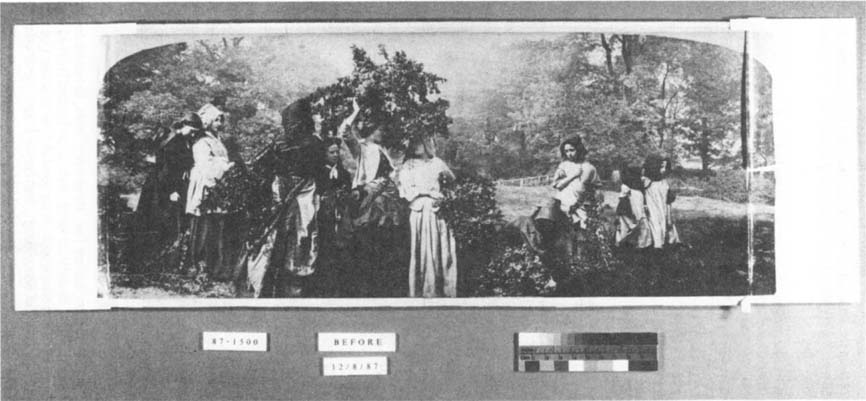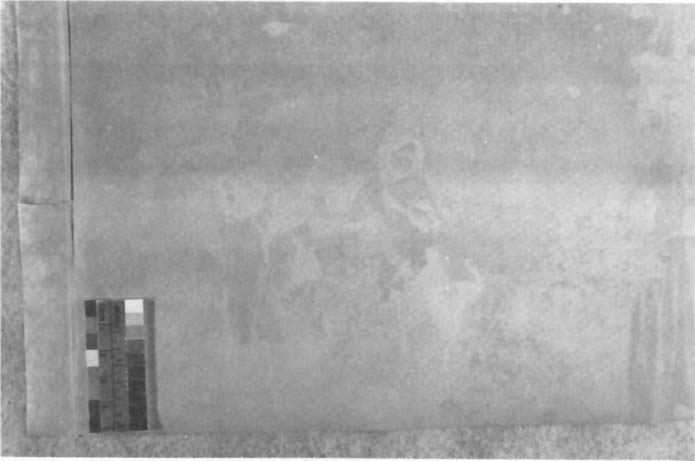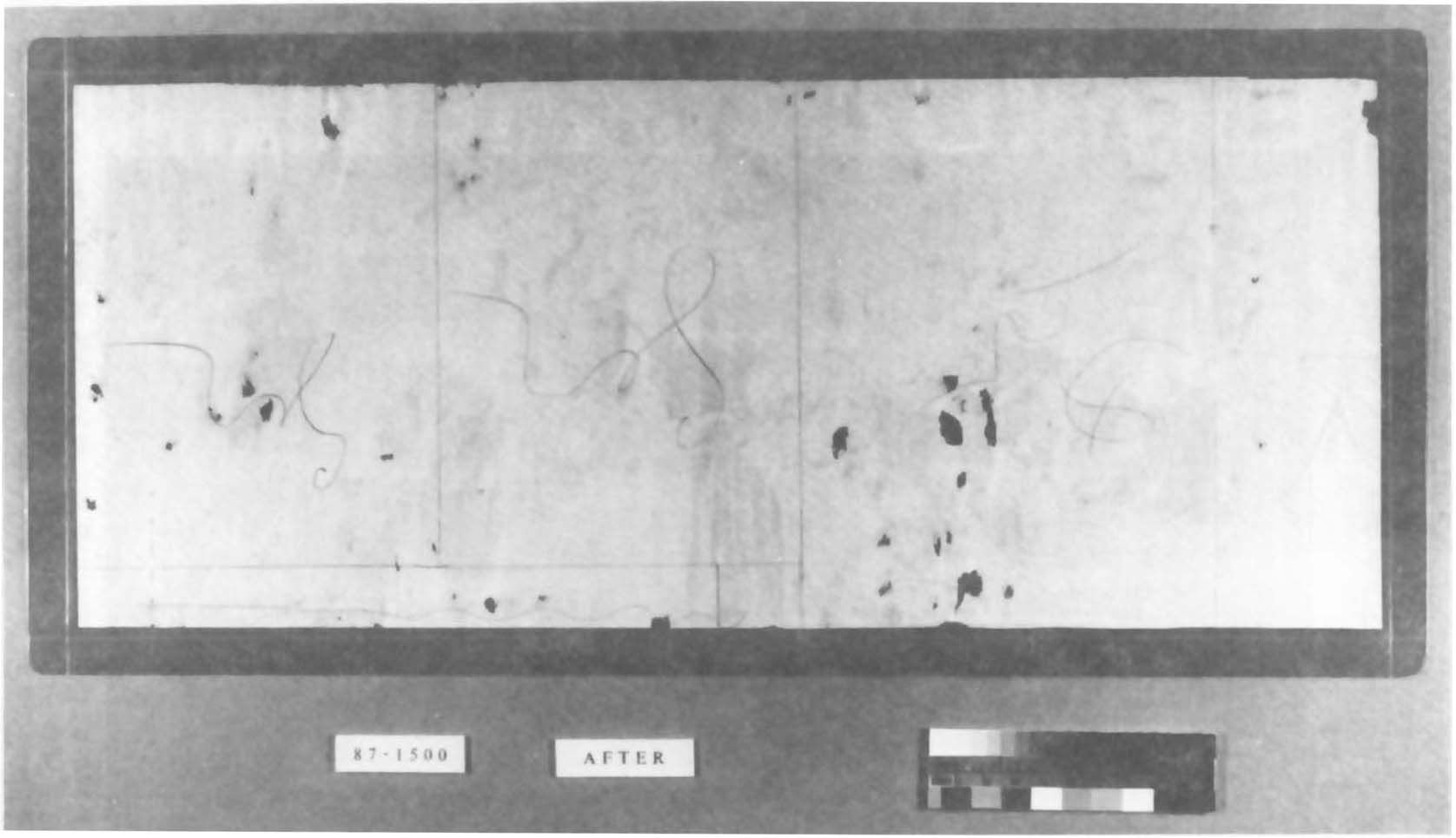
Topics in Photographic Preservation 1989, Volume 3, Article 6 (pp. 37-45)
The foundation and core of the Photography Collection at the Harry Ransom Humanities Research Center (HRHRC) consists of the Gernsheim Collection, an archive of nineteenth- and twentieth century photographic materials and related-artifacts and literature. Created by Helmut Gernsheim over many years and acquired by the University of Texas in 1963, this collection includes works by significant figures in the history of photography, one example of which is Henry Peach Robinson's photograph “Bringing Home the May”. According to the typed entry in Vol. 3 of Gernsheim's original inventory list, this picture was presented to him in August 1950 by Robinson's daughter, Mrs. Edith Abbott. This is corroborated by the correspondence between Gernsheim and Mrs. Abbott, which is now part of the HRHRC's manuscript collections. The inventory entry reads: “Bringing Home the May”, 1862. The smaller version, 19″ × 8 1/4″. Original silverprint in Robinson's original frame, from his home. Presented by his daughter, Mrs. Abbott (aged 91) in August 1950. This picture was his most ambitious composition picture, being made from 9 negatives.”1 This last statement is a paraphrase of Robinson's comments in his article in The Practical Photographer of February 1898.2
“Bringing Home the May” is an albumen print, and thus an example of the major photographic printing medium during the latter half of the 19th century. Wet plate collodion negatives were the usual template for printing an image with this medium. For this image (although perhaps not this particular print, as will be discussed later), the negatives were printed one at a time on one piece of paper. In the aforementioned article, Robinson discussed the process he went through in composing and making this photograph. “Bringing Home the May”, depicts the gathering of greenery and flowers for the celebration of May Day, a custom with which Robinson was familiar from his youth in Ludlow, England. The idea for this image was derived from reading the “May” section of Edward Spenser's poem “The Shepheard's Calendar”. With the picture inspired in his mind “almost as plainly as if it were already photographed,” Robinson then began preliminary sketches and drawings for the composition, often combining pencil, watercolor, and cut-out figures from “test” photographs.3 As part of this composite process, Robinson made notes regarding how much (in terms of images and elements of composition) should go on each plate, where the best places would be for the joins in the final image to appear, and marked these notes on a full-size sketch. The models, costumes, and accessories than had to be selected and prepared, and written on the sketch “so that the photographer should have as little to think of as possible when the important moment [of taking the negative] arrived.4 (Unfortunately for scholars and researchers today, Robinson notes a few lines down in his article that he had “recently destroyed a quantity of [the] preliminary drawings” for this picture.)5 Another consideration in planning the work (one which was beyond the photographer's control) was the weather: for this picture, the negatives could only be taken when the May was in bloom, “which does not last above a fortnight”, as Robinson noted, and sunshine was necessary for photographing the figures.6 The initial printing was difficult for at least two reasons: “the paper had to be specially made as there was none on the market that size [40 × 15 inches]”, and each of the nine wet plate collodion negatives had to be printed separately.7 Subsequently, Robinson fit the negatives with registration marks”, which did help somewhat to simplify the printing process.8
[NOTE: The nine original negatives, as well as the larger version of the photograph are part of the Royal Photographic Society collections. Correspondence dated 20 August 1988, to Roy Flukinger, curator of the HRHRC Photography Collection, from Margaret Harker, past president of the Royal Photographic Society, teacher, noted photo-historian, and author of a recent biography and catalogue raisonnée on Robinson, indicates that the photograph-at the HRHRC was probably made from a single negative that was “copied from the combination print, as a quanitity of these [smaller] prints were made [by Robinson] to distribute to members of the P[hotographic] S[ociety], as stated in the P[hotographic] J[ournal] of 15 Sept. 1863, p. 347.” See also Robinson's article, cited above.]
“Bringing Home the May” in the HRHRC Photography Collection came into the Conservation Lab in 1987, in the condition described as follows (see figure 1). The albumen print was adhered overall to a poor-quality, pulpboard mount – except for portions along the left and right sides. The mounted photograph is slightly wider than the frame in which it originally had been housed: the left and right sides of the photograph, as evidenced by the physical damage in those areas, and lesser degree of yellowing and discoloration, appeared to have been folded around the mount when the object had been fitted into the frame. When the photograph came to the curator's attention, it had been removed from the frame and had been housed in a window mat of museum board using hinges of white cloth tape. (The frame was stored beside the matted photograph.) Attached to the verso of the back matboard, with masking tape along three sides, was a folder of polyester film containing a label written by Gernsheim, which appears to be one that he had attached to the verso of the framed format of the photograph. (The inscription is similar to the typed inventory entry mentioned earlier.)9 It was also noted that the previously folded edges of the photograph were resting on pieces of 4-ply mat board, which supported them in the same plane as the rest of the print. (These secondary supports were attached to the primary mount with pieces of white cloth tape.) The pulpboard mount was very deteriorated and acidic.
Visible along the top and bottom edges of the mount were six vertical graphite marks – three each across the top and bottom. Their significance was unclear, and no other marks were visible on the mount, recto or verso. Thus, it was decided in conjunction with the curator, that this top-most layer would, as much as possible, be retained intact, so that efforts could perhaps be made to determine if the graphite marks extended behind the photograph and whether or not they had any significance.
The albumen print itself was in poor condition. The primary support exhibited slight creases and cockling overall in addition to the obvious damage at the sides. The right side portion had also split horizontally in two, and the top half was completely detached from the rest of the object (barely held in place by a corner of the white cloth tape). Some areas along the bottom edge were detached from the mount, and there were a few small losses and tears or splits in the support.
The albumen binder layer was (and is) considerably yellowed. This deterioration, a result of the natural aging of the protein binder, has been accelerated by prolonged exposure to light and/or exposure to conditions of high temperature and relative humidity. There are slight scratches and abrasions overall, some with corresponding loss in the binder (and image) layer – most noticeable in the upper right. There was a layer of surface grime overall.
The photolytic silver image has an overall brownish tonality, and has lost detail in the hightlight areas, as well as in some deeper shadows. This is due partly to the deterioration of the silver image material (affected/accelerated by the conditions noted above) and partly to the deterioration of the binder. Losses in the image correspond to those in the binder and support.

Figure 1: “Bringing Home the May”, by Henry Peach Robinson (1862); Recto, Normal light, Before Treatment.
The fragile, unstable condition of the mounted albumen print and the damages it had already sustained, placed the object on the curator's priority list for conservation treatment. In its (then) current condition, the photograph could not be safely handled for viewing or study, much less be exhibited. Spot tests for solubilities were conducted, then the treatment proposal was written up and discussed with the curator of the Photography Collection. The treatment was carried out with his approval.
The polyester folder and Gernsheim's label were removed from the verso of the window mat housing, and retained. The mat board secondary supports were detached (by cutting through the tape, along the mount edge) then the outermost backing layers of the pulpboard mount were split away using a Teflonr spatula. Remaining backing material was further reduced first by using Teflon and micro- spatulas, then, as the layers became thinner, scalpels and a sanding block were used until only the final facing layer of the mount remained. [The board was very pulpy and did not split at all readily or evenly. The board was also very dense –water would not penetrate easily, thus the layers were reduced to decrease immersion time.]
The white cloth tape was removed from the upper fragment of the photograph by using a methyl cellulose poultice and then lifting the tape away using a microspatula. Surface grime was reduced/removed overall by first using a soft bristle brush, followed by using a swab slightly moistened with saliva.
The photograph was misted recto and verso with distilled water to evenly dampen/humidify it, and was then immersed, recto up – resting on a support of thin polyester webbing over fiberglass screening and rigid polypropylene screening – into a bath of distilled water, to aid in the removal of the remaining backing layer and any adhesive residues.
After approximately 30 minutes, a thin sheet of polyester film was placed over the recto of the photograph, and both the polyester film and the object were lifted together from the bath and placed recto down upon the light table. Then the remaining layer of backing/mount paper was lifted away using a micro-spatula. (The backing paper came away in two pieces, following a join line between two sheets. These were retained and mended as described later.) At this time, any residual adhesive on the verso of the photograph was removed using small wads of cotton moistened in distilled water.
Upon the removal of the backing sheet from the verso of the photograph, the recto of the backing sheet was found to exhibit several lines and calligraphic marks in graphite. The area is marked vertically into thirds, approximately, and a horizontal line extends from the left edge halfway across the sheet, approximately one inch from the bottom edge of the sheet. The significance of these marks and lines, if any, is not known.
NOTE: As the backing sheet and photograph dried slightly, a negative (reverse tone) image of that in the photograph became visible on the verso of the photograph support (see figure 2) and on the (recto) side of the backing sheet which had been in contact with the photograph (see figure 3). These “negative” images indicate deterioration resulting from acid migration from the backing material combined with photo-oxidation. The binder and support of this photograph are quite thin, and could allow considerable transmission of light in the lower density (highlight) areas of the image. Photo- and chemical oxidation reactions may also have been accelerated by exposure to conditions high temperature and relative humidity.
The photograph was bathed, as described earlier, three more times, to reduce darkening/discoloration in the paper support: first, in distilled water, then in carbonated filtered water, then in a final bath of distilled water. The second bath, of carbonated filtered water (i.e., salt-free seltzer water) was tried at the suggestion of Nancy Heugh, then Senior Paper Conservator in the lab. This procedure is discussed briefly by Anne Clapp in her book Curatorial Care of Works of Art on Paper, where she states that “this treatment will remove water-soluble acids, and with them some of the discoloration. …it will not neutralize the paper, [but] it will make it less acid[ic].”10 This solution leaves no buffer, salts, or compounds behind. The carbonated water readily breaks down into water and carbon dioxide (which is given off as gas bubbles). This bath, in addition to the other baths of distilled water, did considerably reduce discoloration in the paper support, judging from the lightening of the paper support and by the (yellow) discoloration in the baths.

Figure 2: Detail, During Treatment; verso of albumen print (mount and final backing layer removed).

Figure 3: Backing sheet (After Treatment); note faint negative image of that appearing in the photograph.
The photograph was removed from the final bath and placed recto down, on polyester film, on the light table, where the tears and fragments were aligned and mended using Japanese tissue [a machine-made kozo paper in this case, RK-19 by Paper Nao] and wheat starch paste. The photograph was then lined using the same tissue and paste. (The lining tissue was laid cross-grain to that of the paper support to reduce the tendency of the albumen print to curl.) Due to the thin physical structure of the albumen print, and the general tendency of this particular photographic medium to curl when not mounted or similarly restrained, it was decided that the photograph – once lined – would be remounted.
For this situation, Mirager (by Rising Paper Co.), a 2-ply acid-free, neutral paper had been prepared for the new mount using the dacron lining technique: it was stretch lined on polyester fabric over plexiglas using a 3% solution of methyl cellulose. The lined photograph, which had dried between polyester webbing and changes of blotters – under weight – for approximately 1 hour, was very lightly misted with distilled water recto and verso and mounted onto the Mirager using methyl cellulose (slightly diluted as needed from the 3% solution). The assembly was then dried under tension, below polyester webbing, blotters, pressing board, and weights.
Any lifting edges or binder along cracks or tears were set down (reattached) using methyl cellulose, which was diluted as needed from the 3% solution. Areas of loss along cracks were filled using a slurry of cellulose powder11 mixed with distilled water and methyl cellulose. In-painting (or, cosmetic reintegration) of fills was carried out using watercolor, with dilute methyl cellulose added as needed to obtain a surface gloss similar to that of the photographic binder.
The lined and mounted photograph was removed from the polyester fabric and plexiglas, and excess mount board was trimmed away. The lining tissue was allowed to show beyond the edges of the photograph in order to reduce the stark whiteness of the Mirager paper next to the yellowish-brown tonality of the photograph. (The photograph after treatment is shown in figure 4.) The photograph has been hinged into a window mat of acid-free, neutral board using Japanese tissue (kizukishi, hand-made) and wheat starch paste.
The remaining backing layer was mended using a commercially purchased heat-set tissue (the distributor, Bookmakers, specifies it as being made according to the Library of Congress recipe: L-tissue coated with a mixture of the acrylic emulsions Rhoplexr AC 73 and Plextolr B500). The tissue was applied with a tacking iron through silicon-release paper. The backing layer was then encapsulated between 3-mil polyester film which was sealed using the sonic welder (see figure 3).
As a result of this conservation treatment, the physical structure of this photograph has been made more secure and stable, and chemical deterioration has been considerably slowed. The conservation care described and the proper curatorial care and storage received in the Photography Collection contribute to the preservation of this work by a “master of photographic art.”12 “Bringing Home the May”, which Henry Peach Robinson considered “[his] most ambitious effort, but perhaps not [his] best picture,”13 is now more accessible for viewing and for study. Thus, current and future generations will have an opportunity to see and appreciate an example of one of the greater technical undertakings of a major figure in the history of photography.

Figure 4: “Bringing Home the May”; Recto, Normal light, After Treatment.
1 Gernsheim Working Inventory List, 25 volumes, circa 1963, unpaginated. Vol 3.
2 Henry Peach Robinson, “Autobiographical Sketches, Chapter VII”, The Practical Photographer, February 1898, Vol. 9, No. 98, pp. 29–34.
3 Ibid., p. 30.
4 Ibid.
5 Ibid.
6 Ibid.
7 Ibid.
8 Ibid.
9 The inscription, written in blue ink, reads: “‘Bringing Home the May’ in original frame. Composition photograph by H.P. Robinson, (1861)[sic] who called it his most ambitious effort since it was done from 9 negatives. Presented to me by his daughter, Mrs. Abbott, in August 1950.”
10 Anne F. Clapp, Curatorial Care of Works of Art on Paper. New York, NY: Nick Lyons Books, 1987, p. 29.
11 Solka-Floc BW-100, approximately 40–60 long. The cellulose powder was toned before being mixed into a slurry by heating it in a small aluminum weighing pan on a hot plate.
12 Margaret F. Harker, Henry Peach Robinson, Master of Photographic Art, 1830–1901. New York: Basil Blackwell, Inc., 1988.
13 Robinson, The Practical Photographer, p. 29.
* Photographic Conservator Conservation Department, Harry Ransom Humanities Research Center, University of Texas, P.O. Box 7219, Austin, Texas 78713–7219